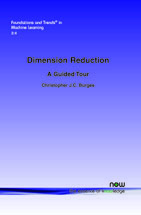Dimension Reduction: A Guided Tour
By Christopher J. C. Burges, Microsoft Research, USA, chris.burges@microsoft.com
Abstract
We give a tutorial overview of several foundational methods for dimension reduction. We divide the methods into projective methods and methods that model the manifold on which the data lies. For projective methods, we review projection pursuit, principal component analysis (PCA), kernel PCA, probabilistic PCA, canonical correlation analysis (CCA), kernel CCA, Fisher discriminant analysis, oriented PCA, and several techniques for sufficient dimension reduction. For the manifold methods, we review multidimensional scaling (MDS), landmark MDS, Isomap, locally linear embedding, Laplacian eigenmaps, and spectral clustering. Although this monograph focuses on foundations, we also provide pointers to some more modern techniques. We also describe the correlation dimension as one method for estimating the intrinsic dimension, and we point out that the notion of dimension can be a scale-dependent quantity. The Nyström method, which links several of the manifold algorithms, is also reviewed. We use a publicly available data set to illustrate some of the methods. The goal is to provide a self-contained overview of key concepts underlying many of these algorithms, and to give pointers for further reading.
Dimension Reduction
Dimension reduction is the mapping of data to a lower dimensional space such that uninformative variance in the data is discarded, or such that a subspace in which the data lives is detected. Dimension reduction has a long history as a method for data visualization, and for extracting key low dimensional features (for example, the 2-dimensional orientation of an object, from its high dimensional image representation). In some cases the desired low dimensional features depend on the task at hand. Apart from teaching us about the data, dimension reduction can lead us to better models for inference. Dimension Reduction: A Guided Tour covers many well-known, and some less well-known, methods for dimension reduction for which the inferred variables are continuous. It describes the mathematics and key ideas underlying the methods, and provides some links to the literature for those interested in pursuing a topic further.
